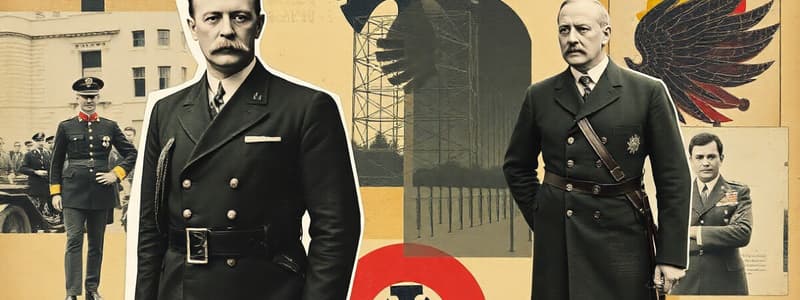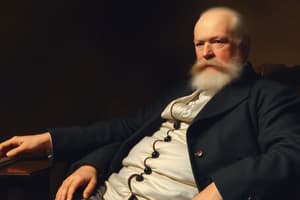Podcast
Questions and Answers
Which of the following best describes Bismarck's strategy towards Catholics and the Social Democratic Party (SPD) within the German Empire?
Which of the following best describes Bismarck's strategy towards Catholics and the Social Democratic Party (SPD) within the German Empire?
- He promoted their ideologies to foster national unity.
- He marginalized them as enemies of the state, restricting their influence. (correct)
- He integrated them into the government to represent diverse interests.
- He sought alliances with both groups to consolidate power against the monarchy.
What key factor contributed to the growth of the working class and its associated social issues during the German Empire?
What key factor contributed to the growth of the working class and its associated social issues during the German Empire?
- Rapid industrialization and urbanization. (correct)
- Government policies promoting small-scale enterprises.
- Agrarian reforms that displaced rural populations.
- A focus on traditional craftsmanship over industrial production.
How did the perception of the Kaiser shift from the beginning to the end of the German Empire?
How did the perception of the Kaiser shift from the beginning to the end of the German Empire?
- From a powerful ruler to a marginalized ceremonial figure with no real influence.
- From a militaristic figurehead towards a symbol of peace and international cooperation.
- From a respected leader to a figure blamed for the empire's downfall and WWI. (correct)
- From an autocratic monarch to a democratically elected official.
Which of the following describes the impact of globalization on German national identity after 1945?
Which of the following describes the impact of globalization on German national identity after 1945?
What characterized the initial concept of a German national identity in the early to mid-19th century?
What characterized the initial concept of a German national identity in the early to mid-19th century?
How did the perception of Germany's 'Sonderweg' (special path) change after World War II?
How did the perception of Germany's 'Sonderweg' (special path) change after World War II?
How did the outcome of World War I and the Treaty of Versailles affect the German national sentiment?
How did the outcome of World War I and the Treaty of Versailles affect the German national sentiment?
What was the prevailing attitude towards the military in the German Empire?
What was the prevailing attitude towards the military in the German Empire?
Which of the following factors contributed to the perceived weaknesses and eventual failure of the Weimar Republic?
Which of the following factors contributed to the perceived weaknesses and eventual failure of the Weimar Republic?
How did the Dawes Plan of 1924 aim to stabilize the German economy?
How did the Dawes Plan of 1924 aim to stabilize the German economy?
What was the significance of the Locarno Treaties of 1925 for Germany's international relations?
What was the significance of the Locarno Treaties of 1925 for Germany's international relations?
Which of the following best describes the impact of the Great Depression on Germany?
Which of the following best describes the impact of the Great Depression on Germany?
What was the 'Dolchstoßlegende' (stab-in-the-back myth) and what role did it play in post-World War I Germany?
What was the 'Dolchstoßlegende' (stab-in-the-back myth) and what role did it play in post-World War I Germany?
How did the extensive use of Article 48 of the Weimar Constitution impact the republic's stability?
How did the extensive use of Article 48 of the Weimar Constitution impact the republic's stability?
Which of the following describes Hindenburg's attitude toward Hitler prior to 1933?
Which of the following describes Hindenburg's attitude toward Hitler prior to 1933?
What was the immediate trigger for the Spartacist Uprising in January 1919?
What was the immediate trigger for the Spartacist Uprising in January 1919?
What was the outcome of the 1919 elections for the National Assembly in Germany?
What was the outcome of the 1919 elections for the National Assembly in Germany?
How did the Weimar Constitution address the issue of gender equality?
How did the Weimar Constitution address the issue of gender equality?
What was the Ruhrkampf of 1923, and what caused it?
What was the Ruhrkampf of 1923, and what caused it?
What triggered hyperinflation in Germany during the early 1920s?
What triggered hyperinflation in Germany during the early 1920s?
Flashcards
Kaiserreich Political Structure
Kaiserreich Political Structure
Founded in 1871 with a Reich constitution, led by Kaiser Wilhelm I, it saw Bismarck wielding considerable power, impacted by parties with limited influence, and evolved into a constitutional monarchy.
Kaiserreich Foreign Policy
Kaiserreich Foreign Policy
Characterized by alliances under Bismarck, naval expansion, rivalry with France, colonial competition, Wilhelm II's detachment from Russia, and encirclement by adversaries, ultimately leading to its downfall in World War I.
Kaiserreich Society
Kaiserreich Society
Marked by insurances, extensive press coverage of the Kaiser, varying inequalities, urbanization, industrialization, the emergence of a working class, economic progress through production, militaristic values, restricted rights for women, population growth fueled by medical advancements and strict schooling with military drills.
German National Sentiment
German National Sentiment
Signup and view all the flashcards
Völkischer Nationalismus
Völkischer Nationalismus
Signup and view all the flashcards
Sonderweg
Sonderweg
Signup and view all the flashcards
Negative Sonderweg
Negative Sonderweg
Signup and view all the flashcards
Individual Identity
Individual Identity
Signup and view all the flashcards
National Identity
National Identity
Signup and view all the flashcards
Preconditions of the Weimar Republic
Preconditions of the Weimar Republic
Signup and view all the flashcards
Proclamation of the Republic
Proclamation of the Republic
Signup and view all the flashcards
After the declaration
After the declaration
Signup and view all the flashcards
Spartacist Uprising
Spartacist Uprising
Signup and view all the flashcards
Versailles Treaty content
Versailles Treaty content
Signup and view all the flashcards
Polarization in the 1920s Causes
Polarization in the 1920s Causes
Signup and view all the flashcards
Stresemann Era
Stresemann Era
Signup and view all the flashcards
Consequences of World War I
Consequences of World War I
Signup and view all the flashcards
Impact of the Global Economic Crisis
Impact of the Global Economic Crisis
Signup and view all the flashcards
Presidential Cabinets
Presidential Cabinets
Signup and view all the flashcards
Reasons for the Failure of the Republic
Reasons for the Failure of the Republic
Signup and view all the flashcards
Study Notes
Deutsches Kaiserreich (1871-1918)
- Politische Struktur:
- Gründung 1871 mit einer Reichsverfassung.
- Parlament (Männerwahlrecht), aber Kaiser Wilhelm I. hatte die größte Macht.
- Parteien hatten wenige Mitwirkungsmöglichkeiten.
- Konstitutionelle Monarchie.
- Bismarck erklärte Katholiken und SPD zu Reichsfeinden, verbot die SPD und trennte Staat und Kirche.
- 1888: Dreikaiserjahr, gefolgt von Wilhelm II., der ohne Bismarck regieren wollte.
- 1900: Einführung eines gemeinsamen Zivilrechts.
- Außenpolitik:
- Viele Bündnisse durch Bismarck.
- Ab 1898 Flottenbauprogramme.
- Frankreich galt als Feind.
- Wettlauf um Kolonien.
- Wilhelm II. löste das Bündnis mit Russland auf.
- Deutschland war von Feinden umzingelt.
- Führt zum Ersten Weltkrieg und dem Untergang des Kaiserreichs.
- Gesellschaft:
- Versicherungen als Teil eines Wohlfahrtsstaats.
- Viel Presse berichtete über den Kaiser.
- Ungleichheiten bestanden fort, mit wenig Rechten für Arbeiter.
- Urbanisierung und Industrialisierung.
- Neue Schicht von Arbeitern mit harter Arbeit und wenigen Rechten.
- Starkes Klassenbewusstsein.
- Schlechte Wohnbedingungen.
- Arbeiterkinder mussten arbeiten statt zur Schule gehen.
- Produktion und Wirtschaftsmacht wurden verstärkt.
- Fortschrittsglaube durch neue Erfindungen.
- Militär wichtig, mit Respekt und Bewunderung.
- Frauen hatten wenig Rechte und Bildung.
- Bevölkerungswachstum durch bessere medizinische Versorgung.
- Strenge Schulen mit militärischem Drill.
- Deutsches Nationalgefühl:
- Beginn bis Mitte des 19. Jahrhunderts: Liberales Bürgertum als Träger, Idee der nationalen Einheit in Freiheit und Mitbestimmung.
- Kaiserreich: Einung der Nation durch Kriege ("Blut und Eisen"), Kaiser als Zentrum der Nation (Reichsmonarchie), Wandel zu einem aggressiven Nationalismus.
- Nach dem Ersten Weltkrieg: Gefühle der Demütigung durch die Versailler Verträge, Gefühl ungerecht behandelt worden zu sein.
- NS-Zeit: Völkischer Nationalismus, Definition von "Deutschtum" vs. "Undeutschen", Exklusion, starkes Überlegenheitsgefühl.
- Nach 1945: Auseinandersetzung mit den Verbrechen des NS, Übernahme von Verantwortung.
- Während der Teilung: Kein gesamtdeutsches Nationalgefühl.
- Nach der Teilung: Langsame Entwicklung eines gesamtdeutschen Bewusstseins.
- Durch Globalisierung abnehmende Wichtigkeit von Nationalstaaten.
- Einfluss durch Immigration und andere Kulturen, Notwendigkeit positiver Identifikationsmöglichkeiten.
Sonderweg Deutschlands
- "Positiver" Sonderweg:
- Anderer Weg in die Moderne als im Westen.
- Volk/Staat im Mittelpunkt, nicht das Individuum.
- Wirtschaftliche Leistungsfähigkeit.
- Effiziente Bürokratie.
- Überlegene Kultur.
- Sozialdarwinismus.
- Negativer Sonderweg:
- Defizite und Rückständigkeit Deutschlands.
- Nationalismus, Militarismus, Imperialismus.
- Radikalisierung zum Nationalsozialismus ab 1945.
- Gründe (nach Hans-Ulrich Wehler):
- Späte Gründung, aggressiver Nationalismus.
- Aufwertung des Militärs durch Siege und Niederlagen in Kriegen.
- Keine bürgerliche Revolution, Liberalismus geschwächt.
- Blockierte Parlamentarisierung und Demokratisierung.
- Politisches Herrschaftssystem: Bismarckregime und Möglichkeit des Führerkults.
- Antiliberale, machtstaatliche politische Kultur/Staatsdenken.
- Kritik:
- Deutsche Geschichte vielfältiger, nicht nur "Sonderweg".
- Vergangenheit nicht nur Vorgeschichte der NS-Zeit.
- Die Frage, was die "Norm" ist.
- Identität:
- Interaktion zwischen individueller und nationaler Identität.
Weimarer Republik (1919-1933)
- Vorgeschichte und Beginn:
- Kriegslage 1918: Viele Tote, schlechte Versorgung, Kriegsmüdigkeit, Niederlagen, soziale und politische Unzufriedenheit.
- Hunger und Armut, Streiks in Rüstungsindustrie, geforderte Reformen durch die Opposition.
- September 1918: Eingeständnis der Kriegsniederlage.
-
- Oktober 1918: Max von Baden neuer Reichskanzler.
- Ende: Waffenstillstandsangebot.
- Ende Oktober 1918: Meuterei der Matrosen, Beginn der Revolution.
- Anfang November 1918: Ausdehnung der Revolution, Bildung von Arbeiter- und Soldatenräten.
-
- November 1918: Ausrufung der Republik (P. Scheidemann: parlamentarische Republik, K. Liebknecht: Räterepublik).
- Ebert wird Reichskanzler, Rat des Volksbeauftragten aus MSPD und USPD.
- Politik:
- Rätekongress in Berlin: Mehrheit für parlamentarische Republik.
- Wahl einer Nationalversammlung, Ausarbeitung einer Verfassung.
- Entscheidung gegen Sozialisierung der Industrie. -Eliten blieben im Amt.
- Entscheidung für ein demokratisches Volksheer.
- Weihnachtskrise.
- USPD verlässt provisorische Regierung, Bildung der KPD.
- Spartakusaufstand (5.-12. Januar 1919):
- Gründe: Wachsende Unzufriedenheit.
- Verlauf: Demonstration, Besetzung von Druckereien, Straßenkämpfe.
- Niederschlagung des Aufstands durch Freikorps.
- Folgen: Viele Tote, demokratische Verfassung, Spaltung der linken Parteien.
-
- Januar 1919: Wahlen zur Nationalversammlung.
-
- Februar 1919: Eröffnung der Nationalversammlung.
- Weimarer Verfassung:
- Reichspräsident, Reichskanzler, Reichsregierung, Reichsrat, Reichstag.
- Grundrechte und Volkssouveränität.
- Versailler Vertrag:
- Beginn der Friedensverhandlungen ohne deutsche Beteiligung.
- Annahme des Vertrags trotz Gegenstimmen.
- Dolchstoßlegende.
- Polarisierung in den 1920er Jahren:
- Ursachen: Inflation, schlechte Wirtschaftslage, Versailler Vertrag, fehlende Wehrhaftigkeit der Verfassung, alte Eliten, instabile Mehrheiten.
- Folgen: Radikalisierung, Putschversuche (Kapp-Lüttwitz, Hitler-Putsch), Ruhrkampf, politische Morde.
- Ruhrkampf:
- Deutsche Rückstände bei Reparationszahlungen, Besetzung des Ruhrgebiets durch Belgien und Frankreich.
- Passiver und aktiver Widerstand, Ende durch neue Regierung unter Stresemann.
- Inflation:
- Währungsreform (Rentenmark).
- "Ära Stresemann":
- Außenminister (1923-1929).
- Ziel: Friedliche Revision des Versailler Vertrags.
- Außenpolitik/Verträge:
- Vertrag von Rapallo (mit Russland).
- Dawes-Plan (Festlegung von Raten und Zahlungen).
- Locarno-Verträge (Anerkennung der Grenzen im Westen).
- Eintritt in den Völkerbund.
- Young-Plan (Reduzierung der Gesamtsumme, Längere Laufzeit).
- Die goldenen Zwanziger:
- Wirtschaftswunder
- Unsicherheit/Realismus/Kontinuität:
- festgelegte Grenzen
- Arbeitslosenversicherung
- Weltwirtschaftskrise:
- Technische Fortschritte, steigende Aktienkurse, späte Zinserhöhung, "Black Thursday", Bankenpleiten
- Psychische und wirtschaftliche Folgen
- Präsidialkabinette:
- Unter Brüning, von Papen
- Art 48
- Scheitern der Republik:
- durch Geschichte + Mentalität zu weniger Unterstützer des Demokratie
- Radikalisierung + Polarisierung nach rechts + links
- alte Eliten -Einzelpersonen durch die Verfassung zu viel Macht
- Massenarbeitslosigkeit
Studying That Suits You
Use AI to generate personalized quizzes and flashcards to suit your learning preferences.




